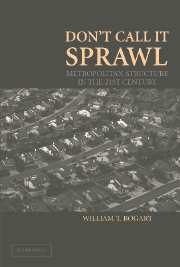Book contents
- Frontmatter
- Contents
- Acknowledgments
- 1 The World of Today
- 2 Making Things Better: The Importance of Flexibility
- 3 Are We There Yet?
- 4 Trading Places
- 5 Downtown: A Place to Work, a Place to Visit, a Place to Live
- 6 How Zoning Matters
- 7 Love the Density, Hate the Congestion
- 8 Homogeneity and Heterogeneity in Local Government
- 9 The World of Tomorrow
- Notes
- References
- Index
6 - How Zoning Matters
Published online by Cambridge University Press: 02 December 2009
- Frontmatter
- Contents
- Acknowledgments
- 1 The World of Today
- 2 Making Things Better: The Importance of Flexibility
- 3 Are We There Yet?
- 4 Trading Places
- 5 Downtown: A Place to Work, a Place to Visit, a Place to Live
- 6 How Zoning Matters
- 7 Love the Density, Hate the Congestion
- 8 Homogeneity and Heterogeneity in Local Government
- 9 The World of Tomorrow
- Notes
- References
- Index
Summary
Zoning, and planning more broadly, constitutes the rorschach test for observers of metropolitan areas. It is blamed for causing a host of problems and hailed as the solution to those problems. In such an environment, this chapter will not try to be definitive. In fact, much of my contribution will be to provide another way of viewing zoning, one that flows directly from the analysis of trading places. Specifically, we will see how zoning operates as a trade barrier and as an inducement to trade. Zoning also has similarities to taxation, and this metaphor is explored. We'll begin, though, in the traditional way, by considering how zoning operates as one way to control externalities.
EXTERNALITIES
Southern California doesn't know whether to bustle or just strangle itself on the spot. Not enough roads for the number of people. Fairlanes, Inc. is laying new ones all the time. Have to bulldoze lots of neighborhoods to do it, but those seventies and eighties developments exist to be bulldozed, right? No sidewalks, no schools, no nothing. Don't have their own police force – no immigration control – undesirables can walk right in without being frisked or even harassed. Now a Burbclave, that's the place to live. A city-state with its own constitution, a border, laws, cops, everything.
Neal Stephenson (1992, 6)Externalities are rampant in urban areas. This can be good, because of the increased productivity created by agglomeration economies of scale. It is also bad, as the intense interaction of people creates conflict.
- Type
- Chapter
- Information
- Don't Call It SprawlMetropolitan Structure in the 21st Century, pp. 118 - 142Publisher: Cambridge University PressPrint publication year: 2006



